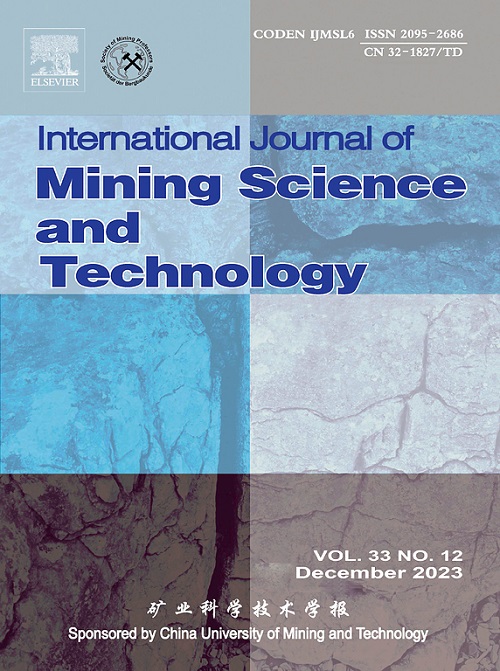NMR-based analysis of the effect of moisture migration on sandstone pore structure under alternating wetting and drying conditions
IF 11.7
1区 工程技术
Q1 MINING & MINERAL PROCESSING
International Journal of Mining Science and Technology
Pub Date : 2024-08-01
DOI:10.1016/j.ijmst.2024.07.014
引用次数: 0
Abstract
The wetting-drying (W-D) cycle is a type of water–rock interaction. The pore structure of rock, such as shape, size, distribution and pore throat, affects fluid storage and transport. Fractal theory and experimental research on the evolution characteristics of pore damage during the wet-dry erosion process are highly important for determining W-D damage. The mass and velocity of liquid migration are related to the pore size, porosity, fluid properties, etc. Experimental data show that the water absorption quality and velocity in rocks decrease with the number of wet-dry cycles. At the same test time, the mass and velocity of the SI water absorption method are smaller than those of the FI method. Under these two conditions, the amount and rate of water absorption represent the degree of water–rock interaction. Considering the pore evolution during the wet-dry cycling, an equation describing the motion of liquid in porous media was derived based on the imbibition-type separation model. The experimental data are in excellent agreement with the calculated values of the model. Permeability characteristics can affect the area and degree of rock deterioration as well as the development rate of pores and microcracks. Based on the interaction between permeability and pores, quantitative analysis of the weakening process (local damage) of rocks under W-D cycles can provide good reference indicators for evaluating the stability of geotechnical engineering.
基于核磁共振技术分析湿润和干燥交替条件下水分迁移对砂岩孔隙结构的影响
润湿-干燥(W-D)循环是水与岩石相互作用的一种类型。岩石的孔隙结构,如形状、大小、分布和孔喉,影响着流体的储存和运输。分形理论和干湿侵蚀过程中孔隙破坏演化特征的实验研究对确定 W-D 破坏非常重要。液体迁移的质量和速度与孔隙大小、孔隙率、流体性质等有关。实验数据表明,岩石中的吸水质量和速度随着干湿循环次数的增加而降低。在同一试验时间内,SI 吸水法的质量和速度均小于 FI 吸水法。在这两种条件下,吸水量和吸水速度代表了水与岩石相互作用的程度。考虑到干湿循环过程中孔隙的演变,根据浸润型分离模型推导出了描述液体在多孔介质中运动的方程。实验数据与模型计算值非常吻合。渗透性特征会影响岩石劣化的面积和程度,以及孔隙和微裂缝的发展速度。基于渗透性与孔隙之间的相互作用,定量分析岩石在 W-D 循环下的削弱过程(局部破坏)可为岩土工程的稳定性评价提供良好的参考指标。
本文章由计算机程序翻译,如有差异,请以英文原文为准。
求助全文
约1分钟内获得全文
求助全文
来源期刊

International Journal of Mining Science and Technology
Earth and Planetary Sciences-Geotechnical Engineering and Engineering Geology
CiteScore
19.10
自引率
11.90%
发文量
2541
审稿时长
44 days
期刊介绍:
The International Journal of Mining Science and Technology, founded in 1990 as the Journal of China University of Mining and Technology, is a monthly English-language journal. It publishes original research papers and high-quality reviews that explore the latest advancements in theories, methodologies, and applications within the realm of mining sciences and technologies. The journal serves as an international exchange forum for readers and authors worldwide involved in mining sciences and technologies. All papers undergo a peer-review process and meticulous editing by specialists and authorities, with the entire submission-to-publication process conducted electronically.
 求助内容:
求助内容: 应助结果提醒方式:
应助结果提醒方式:


